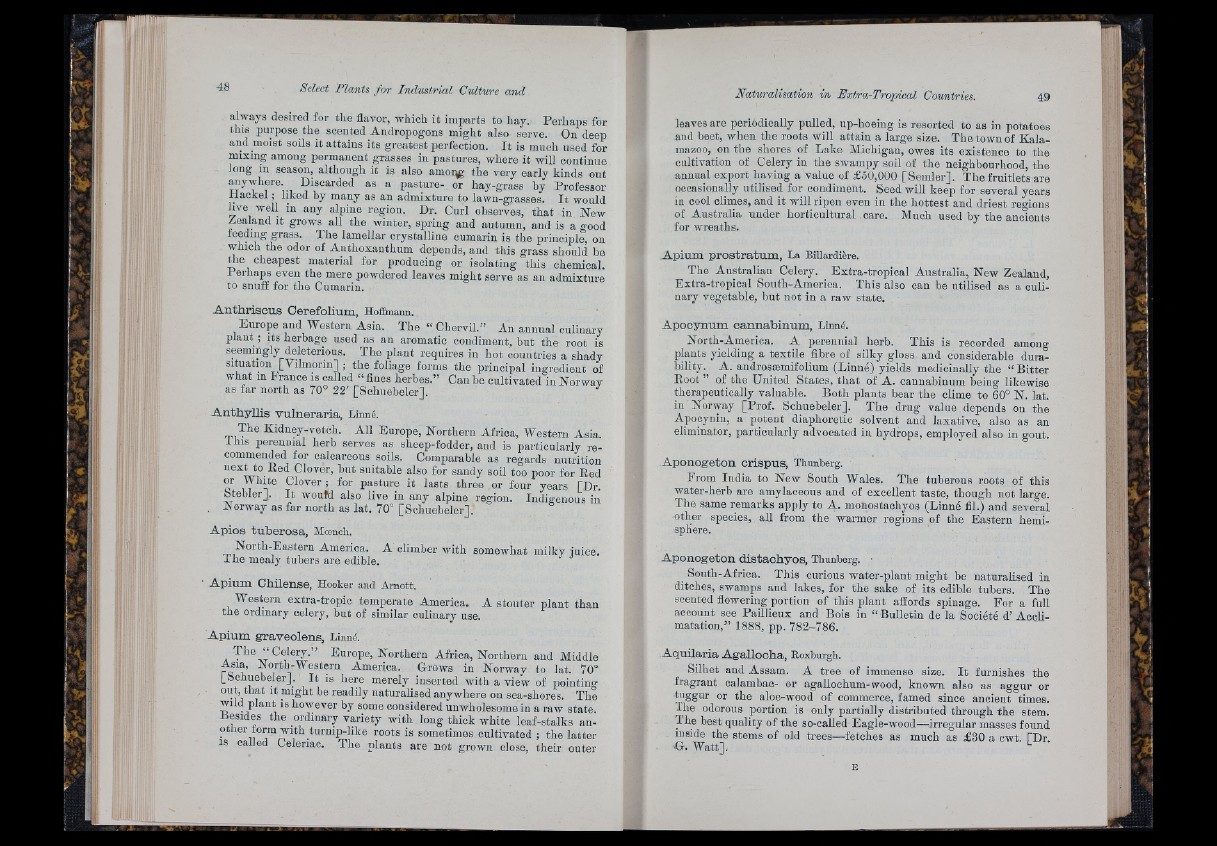
always desired for the flavor, which it imparts to hay. Perhaps for
this purpose the scented Andropogons might also serve. On deep
and moist soils it attains its greatest perfection. I t is much used for
mixing among permanent grasses in pastures, where it will continue
long in season, although it is also amoi^g the very early kinds out
anywhere. Discarded as a pasture- or hay-grass by Professor
Hackel ; liked by many as an admixture to lawn-grasses. I t would
hve well in any alpine region. Dr. Curl observes, th a t in New
Zealand it grows all the winter, spring and autumn, and is a good
feeding grass. The lamellar crystalline eumarin is the principle, on
which the odor of Anthoxanthum depends, and this grass should be
die cheapest material for producing or isolating this chemical.
Perhaps even the mere powdered leaves might serve as an admixture
to snuff for the Cumarin.
A n th r is c u s C e re fo lium , Hofimann.
Europe and Western Asia. The “ Chervil.” An annual culinary
plant ; its herbage used as an aromatic condiment, but the root is
seemingly deleterious. The plant requires in hot countries a shady
situation [Vilmonn] ; the foliage forms the principal ingredient of
what m I ranee is called “ fines herbes.” Can be cultivated in Norway
as far north as 70° 22' [Schuebeler].
A n th y llis v u ln e r a r ia , Linné.
The Kidney-vetch. All Europe, Northern Africa, Western Asia.
I his perennial herb serves as sheep-fodder, and is particularly recommended
for calcareous soils. Comparable as regards nutrition
next to Red Clover, but suitable also for sandy soil too poor for Red
or White Qover ; for pasture it lasts three or four years [Dr.
SteblerJ. I t woutd also live in any alpine region. Indigenous in
. Norway as far north as lat. 70° [Schuebeler].
A p io s tu b e ro s a , Moenoh,
North-Eastern America. A climber with somewhat milky iuioe.
The mealy tubers are edible.
• A p ium Cb ilen se , Hooker and Amott.
Western extra-tropic temperate America. A stouter plant than
the ordinary celery, but of similar culinary use.
A p ium g-raveolens, Linné.
The “ Celery.” Europe, Northern Africa, Northern and Middle
^ l a , North-Western America. Grows in Norway to lat. 70°
[Schuebeler]. I t is here merely inserted with a view of pointing
out, that it might be readily naturalised anywhere on sea-shores. The
wild plant is however by some considered unwholesome in a raw state.
Resides the ordinary variety with long thick white leaf-stalks an-
other fo rra^n th turmp-like roots is sometimes cultivated ; the latter
IS called Celeriac. The plants are not grown close, their outer
leaves are periodically pulled, up-hoeing is resorted to as in potatoes
and beet, when the roots will attain a large size. The town of Kalamazoo,
on the shores of Lake Michigan, owes its existence to the
cultivation of Celery in the swampy soil of the neighbourhood, the
annual export having a value of £30,000 [Semler]. The fruitlets are
occasionally utilised for condiment. Seed will keep for several years
in cool climes, and it will ripen even in the hottest and driest regions
of Australia under horticultural care. Much used by the ancients
for wreaths.
A p ium p ro s tr a tum , La Biliardière.
The Australian Celery. Extra-tropieal Australia, New Zealand,
Extra-tropical South-America. This also can be utilised as a culinary
vegetable, but not in a raw state.
A p o o y n um o a n n a b in um , Linné.
North-America. A perennial herb. This is recorded among
plants yielding a textile fibre of silky gloss and considerable durability.
A. androsaimifolium (Linné) yields medicinally the “ B itter
Root ” of the United States, th a t of A. cannabinum being likewise
therapeutically valuable. Both plants hear the clime to 60° N, lat.
in Norway [Prof. Schuebeler]. The drug value depends on the
Apocynin, a potent diaphoretic solvent and laxative, also as an
eliminator, particularly advocated in hydrops, employed also in gout.
A p o n o g e to n c risp u s , Thunberg,
From India to New South Wales. The tuberous roots of this
water-herb are amylaceous and of excellent taste, though not large.
The same remarks apply to A. monostachyos (Linné fil.) and several
■other species, all from the warmer regions of the Eastern hemisphere.
A p o n o g e to n d is ta o b y o s , Thunberg. •
South-Africa. This curious water-plant might be naturalised in
ditches, swamps and lakes, for the sake of its edible tubers. The
scented flowering portion of this plant affords spinage. For a full
account see Paillieux and Bois in “ Bulletin de la Société d’ Aceli-
matation,” 1888, pp. 782-786.
A q u ila ria A g a llo c b a , Roxburgh.
Silhet and Assam. A tree of immense size. I t furnishes the
fragrant calambao- or agallochum-wood, known also as aggur or
tuggur or the aloe-wood of commerce, famed since ancient times.
Ihe odorous portion is only partially distributed through the stem.
The best quality of the so-called Eagle-wood—irregular masses found
inside the stems of old trees—fetches as much as £80 a cwt. FDr
'G. Watt].